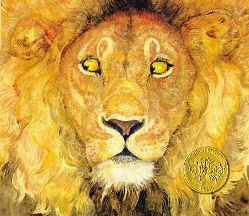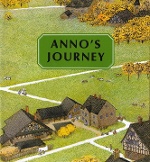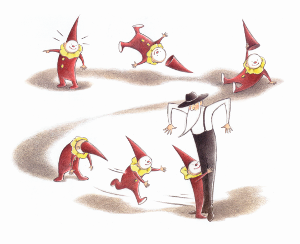How to Read a Wordless Picture Book — The Mary Nagel Sweetser Lecture
How do you read a wordless picture book? You read the pictures — and there are no air quotes around the word read. The pictures are the language and they must be read as carefully as any book with text.
How do you read a wordless picture book? You read the pictures — and there are no air quotes around the word read. The pictures are the language and they must be read as carefully as any book with text.
It’s a radical decision that an artist makes to not use words. When an artist removes the text, they invite readers to decode the pictures for themselves, so every child reads the book in their own unique way according to their own personal life experiences and background. A wordless (or almost wordless) picture book asks children to collaborate in the storytelling process — a very empowering request. That partnership with a child is the most exciting part of my bookmaking experience as an author.
Most people defer to words, so when an adult reads a book with text to a child, the text structures that interaction. You read the text on a page first, and then you see how the art relates to what you’ve just read. When you finish the text on a page, that’s your signal to turn the page. When you get to the end of the entire text, you’re generally done with the book. So it can be unnerving for some to open a book and not have that text to guide them. When you open a wordless picture book, there are only images. You and your child are on your own.
When I read one of my books in public, it’s astonishing how many adults will say, “Oh, I didn’t see that!” Repeatedly. To me it’s one of life’s great questions — at what age, and why, do so many people stop seeing, or stop looking? The late Jerry Pinkney used to tell a great story about his wordless picture book The Lion & the Mouse. After it was published he would get asked, “But when do I turn the page?” And Jerry would say, “When you are ready.” That’s a perfect answer.

The dramatic wordless cover of Jerry Pinkney's The Lion & the Mouse.
The story you tell while reading a wordless book is up to you. Begin by asking questions about what you see. Look at everything on the page. All the imagery has been chosen by the author/artist to tell readers something about the story. Nothing is there by accident. What do you think the characters are doing and why? What do their expressions suggest they are thinking or feeling? Why are the objects in the picture there? Do those things recur in subsequent pictures? If so, why? Most of all, ask your child what they see. Let them lead the way, because they will probably see a lot more than you! Let your child tell the story that they see, in their own words, in their own time.
Research has been done comparing books with and without words in parent/child reading. The comparison that the studies use likens reading a wordless book to free-play activities, such as playing with Play-Doh or building with LEGO, where parent and child converse while playing.
From a 2012 study by Jessica Nielsen at Utah State University:
In books containing print, parents may feel constrained to read the words and follow the prescribed story line, which may inhibit their responsiveness to children’s linguistic input. Parents may feel compelled to “cover the content” in the book, rather than allow for tangential linguistic interactions that often occur during unstructured activities resulting in more directive than responsive behaviors.
And:
Wordless books may more closely mirror play contexts because there is no prescribed linguistic information or content that caregivers must follow. While the pictures are suggestive of the direction the story may take, the final story is the result of the interaction between the parent, the child, and the pictures in the book.
Because of this kind of interaction during book sharing, where the parent is not directing the conversation but following the child’s lead, researchers found a much higher number of words used by the child than during the sharing of a book with text. In essence, a book without words generates much more language from a child.
Teachers have long known how to use wordless books as springboards for creativity for all students, and how wordless books can help those learning English or struggling with dyslexia and other reading issues.
 A wordless book frees those struggling kids from the hurdle of words and releases their imaginations and storytelling skills. I’ve had many letters about the joy felt by children reading my books because the anxiety the text can cause was lifted. One came from a mother in London whose son would labor for an hour to write a few sentences and the frustration he, and she, felt. One day the assistant teacher in his class gave him my wordless book Tuesday and told him to tell the story. She let him get up and walk around, because sitting still was so confining for him. She then followed the boy around as he talked, writing down his long, detailed story. His mother was so happy about the boy’s excitement over his act of storytelling, something he dreaded when required to write with a pen. She sent me the story, and it is quite remarkable. Of course, the real hero of this story is the assistant teacher who took the initiative and made the effort to help this child. And it could have been any wordless book, not just mine. But that’s the kind of joy wordless stories can offer.
A wordless book frees those struggling kids from the hurdle of words and releases their imaginations and storytelling skills. I’ve had many letters about the joy felt by children reading my books because the anxiety the text can cause was lifted. One came from a mother in London whose son would labor for an hour to write a few sentences and the frustration he, and she, felt. One day the assistant teacher in his class gave him my wordless book Tuesday and told him to tell the story. She let him get up and walk around, because sitting still was so confining for him. She then followed the boy around as he talked, writing down his long, detailed story. His mother was so happy about the boy’s excitement over his act of storytelling, something he dreaded when required to write with a pen. She sent me the story, and it is quite remarkable. Of course, the real hero of this story is the assistant teacher who took the initiative and made the effort to help this child. And it could have been any wordless book, not just mine. But that’s the kind of joy wordless stories can offer.
Most of the choices an artist makes when creating a wordless book are also made when illustrating a book with text. But in a wordless book the artist puts a much more intense visual focus on communicating the story. Without text as a partner, the pictures have to communicate everything. Facial expressions and body language tell the reader what the characters are thinking and feeling, aided by lighting, color, and composition. The setting and objects in the pictures can also tell us about the characters, as can the design of the pages. The size of a picture affects how the reader responds to a character, as does the size of the character within the picture. It is through all this visual information that a child reads the story.
The connections between each of the pictures are critical. It must be clear how and why every image relates to the one before and after it. Text can easily say that the story has moved ahead in time or into a different location, but pictures must show those things happening in a way that doesn’t confuse the reader. It’s okay if the visual connections are subtle. A reader may not see them immediately, but they need to be there — you just have to look for them. When I am working, I am continually thinking about how children will read the pictures, individually and collectively, so that the story moves forward in a logical way.
I myself came to the form of wordless picture books as a means of artistic expression. When I first saw examples of wordless stories, I was so excited, because pictures were a language I was fluent in. The concept made immediate sense to me. The first wordless stories I saw were from comic-book artists Jim Steranko in Marvel Comics and Jean “Moebius” Giraud in Heavy Metal magazine. Later, as a student at the Rhode Island School of Design, I found Max Ernst’s surrealist collage novel Une Semaine de bonté, Edward Gorey’s The West Wing, and Lynd Ward’s woodcut novels. From seeing these books I knew two things — I wanted to make books and I wanted them to be wordless.
Obviously, those inspirations were not children’s books. I wasn’t even aware there were other children’s wordless picture books until I had already made two of them. After Free Fall (1988) and Tuesday (1991) were published, I began exploring the history of wordless storytelling, first in older books by Peter Spier, Mitsumasa Anno, Jörg Müller, John S. Goodall, Tana Hoban, Molly Bang, Donald Crews, and Raymond Briggs, and then finding new titles as every year brought more.
There are many different ways to organize images in wordless books. Some artists use a fixed format with a single picture on each page, while others use a wide range of page designs incorporating a multitude of images. The fixed approach includes books such as Anno’s Journey, Suzy Lee’s Wave, and Peter Sís’s An Ocean World. Both Journey and Wave use only double-page spreads. In Anno’s book each spread is dense with information and readers have to immerse themselves in reading all the details. In Wave, the compositions are simple and each spread focuses all our attention on the emotional interplay between a child on a beach and an ocean wave. Each page-turn presents the next step in the evolving relationship between the two characters. In An Ocean World, Sís follows a whale released into the wild as she has a series of natural and man-made encounters. On each page he contrasts the shape of the whale with the similarly shaped things she meets — visual variations on a theme.



Books such as Peter Spier’s Rain, Shaun Tan’s The Arrival, Marla Frazee’s The Farmer and the Clown, and Matthew Cordell’s Wolf in the Snow use double-page spreads, full single-page images, and pages that are divided into multiple panels. Rain tells the simple story of two children playing in the rain, while The Arrival tells the complex story of characters finding their ways in an unfamiliar world. Both books have pages with many, many panels. These multi-paneled pages can be used to play with time. A single, short action may stretch across many panels to slow that action down so we can see it in great detail. Conversely, time can make large jumps from panel to panel on a single page.




The Farmer and the Clown and Wolf in the Snow use only two or three images in their paneled pages, but they also add pages with vignettes of their characters against white backgrounds. These pages isolate the characters from the environments to more fully focus attention on their emotional interactions.

The Farmer and the Clown (c) 2014 by Marla Frazee. Illustration used with artist's permission.
I use paneled pages frequently in my books. The eye reads the multi-paneled pages quickly, and I like to contrast them with full-page pictures or double-page spreads that are filled with details, pages that need time for a reader to absorb all the visual information they contain. I’m creating a rhythm to the reading experience, sometimes moving faster and sometimes slower.


Flotsam (c) 2006 by David Wiesner. Illustrations used with artist's permission.
These are only a few examples of the decisions artists make when writing a wordless picture book. The stories are in the pictures, and every mark on a page means something. But we artists won’t know how those pictures will be interpreted until children read our books. Every interpretation will be unique, and we can’t know them all, but we are fortunate because of the teachers and librarians who share responses from children with us.
Wordless books fuel kids’ imaginations. My favorite response came to me from a librarian who picked up a copy of Flotsam and discovered small pieces of paper between every page. A child had written her version of the story, cut it up into strips, and inserted the strips into the book. The child then put the book on the cart to be re-shelved, because maybe someone else would want to read it! I love that this was not an assignment, and that the librarian didn’t even know who had done it. This child literally put their words into my book. My story is now complete — until another child reads it.
Deconstructing Mr. Wuffles!
This article is adapted from David Wiesner's 2021 Mary Nagel Sweetser Lecture. From the January/February 2022 issue of The Horn Book Magazine.

RELATED
ALREADY A SUBSCRIBER? LOG IN
We are currently offering this content for free. Sign up now to activate your personal profile, where you can save articles for future viewing.










Add Comment :-
Comment Policy:
Comment should not be empty !!!